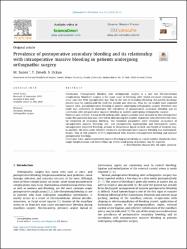| dc.contributor.author | Süzen, Muazzez | |
| dc.contributor.author | Develi, Tuba | |
| dc.contributor.author | Uçkan, Sina | |
| dc.date.accessioned | 2021-03-19T06:07:10Z | |
| dc.date.available | 2021-03-19T06:07:10Z | |
| dc.date.issued | 2021 | en_US |
| dc.identifier.citation | Süzen, M., Develi, T. ve Uçkan, S. (2021). Prevalence of postoperative secondary bleeding and its relationship with intraoperative massive bleeding in patients undergoing orthognathic surgery. Journal of Stomatology, Oral and Maxillofacial Surgery, 122(1), 29-32. https://dx.doi.org/10.1016/j.jormas.2020.05.002 | en_US |
| dc.identifier.issn | 2468-8509 | |
| dc.identifier.issn | 2468-7855 | |
| dc.identifier.uri | https://dx.doi.org/10.1016/j.jormas.2020.05.002 | |
| dc.identifier.uri | https://hdl.handle.net/20.500.12511/6629 | |
| dc.description.abstract | Introduction: Postoperative bleeding after orthognathic surgery is a rare but life-threatening complication. Maxillary surgery is the main cause of bleeding, after which excessive epistaxis can occur until the 10th postoperative day. Due to the risk of secondary bleeding, the patient discharge process may be complicated for both the patient and clinician. Thus far, no studies have explored massive intraand postoperative bleeding in patients undergoing orthognathic surgery. Therefore, this study was performed to determine the prevalence of postoperative secondary bleeding and its correlation with intraoperative massive bleeding in patients undergoing orthognathic surgery.Materials and methods: A total of 206 orthognathic surgery patients were included in this retrospective study. Perioperative data was collected by determining the number of patients who referred to the clinic for treatment of secondary bleeding. The following parameters were recorded: occurrence of intraoperative massive bleeding, preand postoperative haemoglobin and haematocrit values, intraoperative projected bleeding, amount of intravenous liquid needed, and length of hospital stay. In addition, the association between secondary and intraoperative massive bleeding was investigated.Results: Two of 206 patients (0.97%) experienced both massive intraoperative bleeding and massive postoperative bleeding.Conclusion: Intraand postoperative massive bleeding occurred only in a small number of patients; thus, longer hospitalisation and strict follow-up of this small group of patients may be required. | en_US |
| dc.language.iso | eng | en_US |
| dc.publisher | Elsevier | en_US |
| dc.rights | info:eu-repo/semantics/embargoedAccess | en_US |
| dc.subject | Secondary Bleeding | en_US |
| dc.subject | Orthognathic Surgery | en_US |
| dc.title | Prevalence of postoperative secondary bleeding and its relationship with intraoperative massive bleeding in patients undergoing orthognathic surgery | en_US |
| dc.type | article | en_US |
| dc.relation.ispartof | Journal of Stomatology, Oral and Maxillofacial Surgery | en_US |
| dc.department | İstanbul Medipol Üniversitesi, Diş Hekimliği Fakültesi, Ağız, Diş ve Çene Cerrahisi Ana Bilim Dalı | en_US |
| dc.authorid | 0000-0001-5121-9158 | en_US |
| dc.authorid | 0000-0002-7481-2437 | en_US |
| dc.authorid | 0000-0003-1077-7342 | en_US |
| dc.identifier.volume | 122 | en_US |
| dc.identifier.issue | 1 | en_US |
| dc.identifier.startpage | 29 | en_US |
| dc.identifier.endpage | 32 | en_US |
| dc.relation.publicationcategory | Makale - Uluslararası Hakemli Dergi - Kurum Öğretim Elemanı | en_US |
| dc.identifier.doi | 10.1016/j.jormas.2020.05.002 | en_US |
| dc.identifier.wosquality | Q4 | en_US |
| dc.identifier.scopusquality | Q2 | en_US |


















